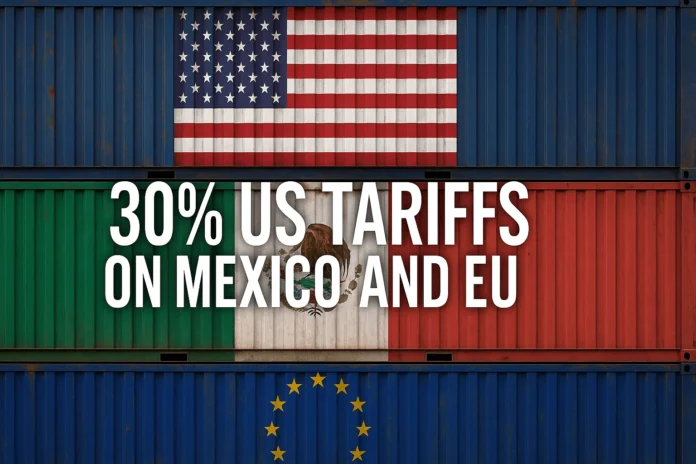The Big Shift: How US Tariffs on Mexico and EU Will Change Trade Relations
On July 12, 2025, U.S. President Donald Trump formally announced that goods imported from Mexico and the European Union will face 30% US tariffs starting August 1, 2025. This bold move, communicated through direct letters to Mexico and EU leadership, underscores growing economic friction and escalating dissatisfaction over unresolved trade issues and border control failures.
This shift marks a defining moment in U.S. trade policy, with the new tariffs set to impact billions in global trade, supply chains, and diplomatic relations.
Mexico Under Scrutiny: Why It’s in the Crosshairs
Fentanyl Crisis Cited as Key Cause
Trump’s letter to Mexican President Claudia Sheinbaum attributed the decision to what he called Mexico’s failure to stop drug cartels responsible for the flow of fentanyl into the U.S. He stated, “Mexico has been helping, but it is not enough.”
This framing presents the tariffs not just as economic penalties but as tools of national security, linking trade policy directly to the U.S. opioid crisis.
30% US Tariffs: A Standalone Penalty
Unlike previous tariffs, which were sectoral or based on existing trade agreements like USMCA, this 30% US tariff on Mexican goods will be separate and across the board, according to Trump. This could significantly disrupt sectors such as agriculture, automotive, and consumer electronics.
Why the EU Is Also Facing the 30% US Tariffs
Trade Deficit with Europe Highlighted
In a similar letter addressed to the President of the European Commission, Trump argued that the U.S. trade deficit with the EU has become unsustainable. In 2024 alone, the deficit exceeded $235 billion, according to U.S. trade data.
Trump underlined that until EU businesses move their production to the United States, anything manufactured in the EU and exported to the United States will be subject to a 30% tariff.
Incentive to Manufacture in the U.S.
Trump encouraged European companies to move manufacturing to the United States, promising that regulatory approvals would be completed “in weeks, not months.” This tactic is designed to repatriate industrial jobs while disincentivizing transatlantic imports.
No Tariff – If You Build in America
To avoid the 30% US tariffs on Mexico and EU, both Trump’s letters emphasized that businesses will not be taxed if they build or manufacture in the United States. The letters suggested that approvals and permits would be fast-tracked to support investment.
This positions the tariff policy as both a punishment for offshoring and an incentive for reindustrialization.
How the Global Economy Is Reacting
European Commission Response
European leaders have expressed strong opposition to the tariff hike. EU officials warn that these measures could lead to a breakdown in trade relations and potential retaliation in the form of countertariffs on U.S. exports.
EU member states such as Germany, France, and Ireland have called for urgent diplomatic negotiations to prevent economic disruption.
Mexico’s Position
Mexican officials argue that the unilateral imposition of a 30% US tariff violates the spirit of existing trade agreements and risks destabilizing North American economic cooperation. They are expected to enter emergency trade talks with U.S. counterparts in the coming weeks.
Economic Impact: Who Pays the Price?
| Stakeholder | Impact |
| U.S. Importers | Higher costs and squeezed margins on goods from Mexico and the EU. |
| Consumers | Potential price hikes on everyday items like cars, electronics, and food. |
| EU/Mexico Exporters | Declining competitiveness in the U.S. market. |
| U.S. GovernmentPossible increase in tariff revenue but risk of inflation. | |
| Global Markets | Increased volatility, particularly in sectors like automotive and tech. |
Legal and Political Challenges
Legal Pushback Possible
Several legal analysts note that imposing sweeping tariffs based on security claims could be challenged in U.S. courts. A similar move in 2023 was halted due to procedural overreach. Lawsuits from industry groups, trade unions, or foreign governments may delay or weaken the effectiveness of the new tariff strategy.
Election-Year Politics
With the 2026 midterm elections approaching, this aggressive trade maneuver may be viewed as a political strategy to appeal to voters in manufacturing-heavy swing states like Michigan and Pennsylvania.
The Timeline: What Happens Next?
- July 15–31, 2025: Last-minute diplomatic efforts are likely. Both Mexico and EU may propose alternate trade arrangements or increased enforcement measures to avoid tariffs.
- August 1, 2025: The 30% US tariffs on Mexico and EU officially take effect unless repealed or blocked.
- Q3–Q4 2025: Businesses begin restructuring supply chains. Market volatility expected.
- 2026 and Beyond: Possible trade realignment as U.S. negotiates new deals with other regions.
Long-Term Implications
The enforcement of these tariffs could lead to:
- Regional trade reshuffling, particularly within North America and Europe.
- Increased investment in U.S.-based manufacturing, particularly from firms looking to avoid long-term tariff risk.
- Reduced dependency on transatlantic supply chains, accelerating trends already underway since the pandemic.
Conclusion: Is This the Start of a New Trade Era?
The announcement of 30% US tariffs on Mexico and EU marks a significant pivot in America’s global trade strategy. Framed as both a security and economic policy, it attempts to reassert U.S. dominance in global trade and compel allied nations to fall in line with American priorities.
Whether it results in positive transformation or increased economic friction depends largely on what happens in the next few weeks. Trade watchers, businesses, and political analysts are closely monitoring every move.


